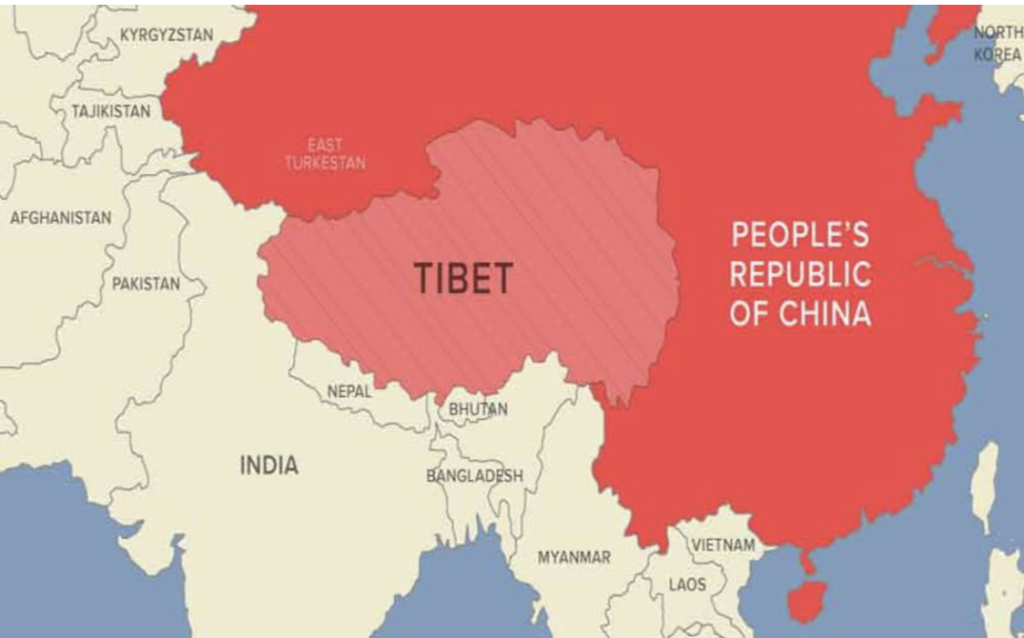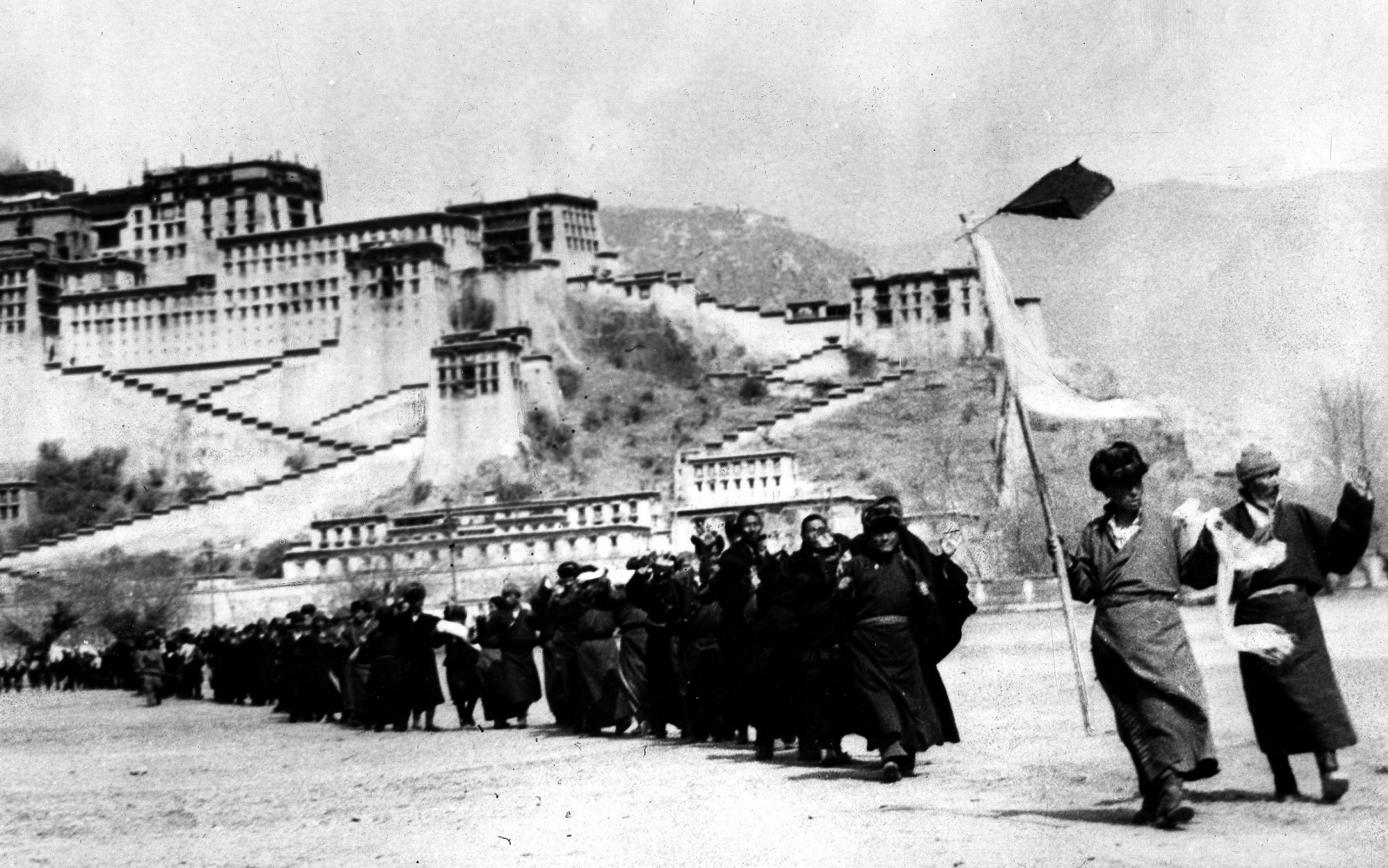When we hear the name TIBET. Images of breathtaking landscapes and ancient Buddhist monasteries immediately come to mind.However, Tibet’s allure extends far beyond its physical charm. It embodies a profound history of – Struggle, A relentless quest for freedom, Justice and Cultural preservation against the backdrop of Chinese governmental oppression, epitomized by the Tibetan Uprising of 1959. The seeds of Tibetan resistance were sown almost immediately following China’s annexation, with the Tibetan people fiercely resisting the imposition of Chinese authority. This resistance reached its peak on March 10, 1959.
March 10 is a crucial date for the Tibetan struggle. On that day in 1959, thousands of Tibetans gathered around the Potala Palace in Lhasa, the residence of the Dalai Lama, to protect him from the Chinese soldiers who wanted to take him away. But the situation turned violent. The uprising escalated into violence as Tibetans resisted the Chinese presence in their country.The Chinese government didn’t tolerate this uprising. They used force to stop and crush it. Many Tibetans lost their lives, and on March 17, 1959, the Dalai Lama had to leave Tibet and escape to India for his safety. This event marked a turning point in Tibetan history, leading to decades of resistance against Chinese rule and ongoing international attention to the situation in Tibet.
Despite many years passing and calls for freedom, Tibet is still under Chinese control. The Chinese government has a strong grip on Tibet. They don’t allow people to speak up against them, and they’re trying to erase Tibetan culture. In 2019, the world observed the 60th anniversary of a human rights tragedy that claimed tens of thousands of lives. And a brave act of resistance that determined the fate of an entire country.

Here’s an overview of how the struggle is shaping up, both inside and outside Tibet.
Tibet’s Pre-1959 Era – Peaceful Time
Before 1959, Tibet was full of Deep Spirituality, Cultural Richness and Unique Societal Structures, with a history stretching back over 2,000 years. In ancient times, Tibet consisted of independent tribes and kingdoms also.
Ancient Society
Tibet had a social structure based on Tibetan Buddhism and a feudal system led by the Dalai Lama, who served as both the spiritual and temporal leader of Tibet. Monasteries played a central role in Tibetan society, serving as hubs of learning, governance, and religious practice. You can view the list of Tibetan monasteries here – https://en.wikipedia.org/wiki/List_of_Tibetan_monasteries
Era of Isolation and Autonomy
Tibet was relatively isolated from the rest of the world due to its rugged terrain and geographic location. This isolation contributed to the preservation of Tibetan culture, language and religious traditions.
Tibetan Buddhism
Buddhism was introduced into Tibet from India in the 600s and became the dominant religion, shaping every aspect of life in the region. By the 7th century, Buddhism had firmly taken root in Tibet, catalysing significant cultural and other aspects of society. Monasteries and temples help in Buddhist teachings and rituals in daily life of Tibetans.
Nomadic Way of Life
Majority of Tibet’s population lived a Nomadic or Semi-nomadic lifestyle. It means herding yaks and sheep across the vast grasslands of the Tibetan Plateau. Nomads lived in traditional yak hair tents called “black tents” and relied on their herds for food, clothing and shelter. Approximately 85% of Tibet’s population engaged in nomadic pastoralism during the early 20th century.
Presence of Cultural Richness
Tibetan culture flourished with vibrant art, music, dance and literature. Thangka paintings, intricate wood carvings and colourful festivals are the richness of Tibetan artistic expression. Tibetan literature, including religious texts, poetry and historical chronicles, played a vital role in preserving Tibetan identity and heritage.
Political Dynamics
Tibet had a complex relationship with neighbouring China. Throughout history, Tibet experienced periods of independence and Chinese influence. By the early 20th century, several nations recognized Tibet’s sovereignty. On March 26, 1959, the Dalai Lama declared Tibet’s independence.
Atmosphere that Led to Tibetan Uprising of 1959
In 1950, the Chinese Communist Party made a decisive move to assert control over Tibet:
Chinese Occupation: Initial Actions
The People’s Liberation Army of China invaded Tibet in 1950, claiming it as part of Chinese territory. Over 40,000 Chinese troops entered Tibet during the invasion, announcing the beginning of China’s military presence in Tibet. This injustice was met with resistance from many Tibetans who viewed it as a threat to their autonomy and cultural heritage.
Implementation of Oppressive Policies
Following the invasion, the Chinese government implemented various oppressive policies in Tibet, including land reforms, religious suppression and attempts to erode Tibetan culture and language. Military destroyed the sacred Tibetan monasteries and monks and nuns were subjected to forced labour and political indoctrination.
Resentment and Unrest
These policies fuelled growing resentment and unrest among Tibetans. Throughout the 1950s, there were 200 documented aggressive protests and resistance movements against Chinese atrocities.
Rumors of Dalai Lama’s Arrest
In early 1959, rumours spread that the Chinese authorities planned to arrest the 14th Dalai Lama, Tenzin Gyatso. The Dalai Lama’s arrest sparked widespread concern and anger among Tibetans, intensifying the atmosphere of unrest and resistance.
Wind that Changed the Map of Tibet
After 1959, Tibet experienced profound transformations following the Tibetan Uprising against Chinese rule.
- Exile of the Dalai Lama and Key Figures: The 14th Dalai Lama, Tenzin Gyatso, fled into exile in India along with a large number of Tibetans. He established the Tibetan government-in-exile in Dharamshala, India. On 3rd April 1959 Jawaharlal Nehru, the Indian Prime Minister , announced that India had granted asylum to the Dalai Lama.
- Chinese Control: Following the Uprising, Tibet fell under the direct administration of the People’s Republic of China. The Chinese government implemented policies to integrate Tibet into the socialist system, which included land reforms, collectivization of agriculture and the suppression of religious and cultural practices.
- Cultural Suppression: China launched campaigns to suppress Tibetan Buddhism and traditional culture, resulting in the destruction of monasteries, the persecution of monks and nuns and attempts to replace Tibetan language and customs with Chinese ones.
- Infrastructure Projects: China initiated numerous different infrastructure projects in Tibet, which includes roads, railways and airports. While these projects aimed to improve connectivity and economic development, they also led to concerns about environmental degradation and the marginalization of Tibetan communities.
- Demographic Shifts: Tibetan regions experienced significant migration of Han Chinese settlers, leading to demographic changes and sparking concerns among Tibetans about cultural assimilation and loss of their identity.
- Global Attention: The situation in Tibet has drawn international scrutiny, with human rights organizations and several governments criticizing China’s policies in the region. Criticisms primarily focus on violations of religious freedom, cultural preservation and human rights violations.
International Backing: Allies for Tibet’s Cause
After the Chinese invasion in Tibet, many nations came forward to support Tibet. Majorly in advocating for Tibetan autonomy and addressing human rights concerns.
- Diplomatic Support: Countries like Australia, Canada, United States and European nations have raised serious concerns about China’s policies in Tibet. Their diplomatic support includes calling China to talk with Tibetan leaders to solve problems and find a peaceful solution for Tibet.
- Official Statements – United Nations and the European Nations have issued official statements condemning human rights violations in Tibet and urging China to respect the rights of Tibetans. Moreover, these statements highlight concerns about; Religious Freedom, Cultural Preservation, and Treatment of Tibetan Political Prisoners.
- Humanitarian Aid – Nations such as India, Nepal and various Western countries facilitate humanitarian aid to Tibetan communities, particularly those living in exile. The motto is to improve the well-being of Tibetans. The aid includes – Funding for education, Healthcare and Refugee support programs.
- Advocacy and Awareness Campaigns: NGOs, advocacy groups, and individuals worldwide advocate for Tibet through Awareness campaigns, Petitions and Lobbying efforts. The prime aim is to spread awareness about the Tibet situation worldwide.
- Legislative Measures: Countries like the U.S.A and members of the European Parliament, have introduced strong legislative measures to support Tibet. These actions involve making decisions or laws to fix problems with human rights in Tibet or to help Tibetan people who had to leave their homes. Plus, these actions involve the limiting trade or diplomatic ties with China because of how China treats Tibet.
Tibet Uprising: Real Numbers and Facts
| Aspect | Number |
| Date of Tibet Uprising | March 10, 1959 |
| Date of Women’s Uprising | March 12, 1959 |
| Tibetan Casualties | Thousands (exact number disputed) |
| Chinese Crackdown | Thousands arrested, tortured, and executed |
| Tibetan Diaspora | Hundreds of thousands |
| Women’s Participation | Thousands |
| Women’s Casualties | Number not specified |
| Date of International Attention | Post-1959 |
| International Support for Tibetan Cause | Ongoing |
Is There Hope for Tibet’s Future?
Considering the current circumstances, the future of Tibet looks uncertain as China maintains a firm control. Interestingly, finding a right solution that meets the needs of both Tibetans and China has proven to be a daunting challenge for the international community. The China-Tibet issue is multifaceted, encompassing cultural, political and human rights considerations. Calls for dialogue echo worldwide, seeking a peaceful resolution to the enduring tensions between Tibet and the Chinese government. Amid widespread dissatisfaction in Tibetans and atrocities of China, hopes for Tibet’s future remain uncertain.

